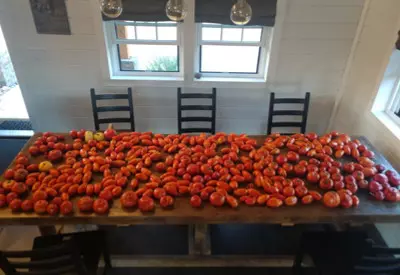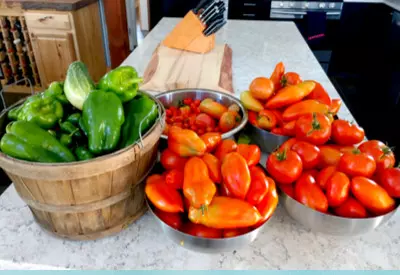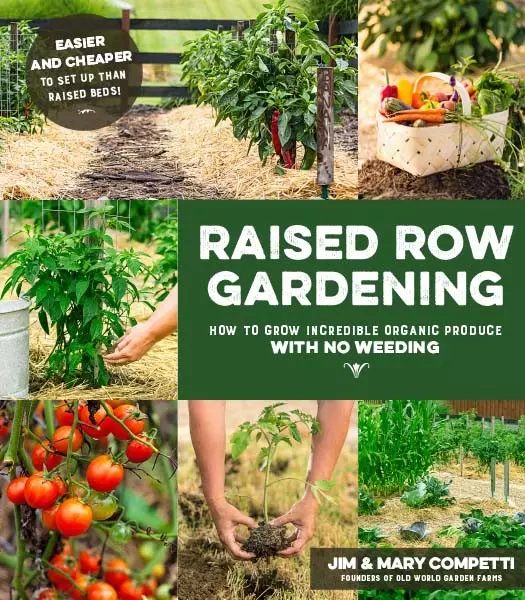It has been simply nothing short of a record-setting harvest for our raised row garden this year!
To date, over 1000 tomatoes, 100+ green bell peppers, and a few hundred more of both sweet and hot peppers have been pulled from the garden. And that all comes on the heels of a huge cucumber, zucchini, and garlic harvest.
But perhaps funniest of all, there is still double that harvest amount sitting on our tomato and pepper plants! Yes indeed, it has been both a record-setting harvest year, and a proving year for Raised Row Gardening.
A Record-Setting Harvest

Heading into this year, we knew it was going to be a tough gardening year. With the move down south, we knew we wouldn’t be able to give the garden the daily attention it has always had. We were simply going to have to rely on the system of no-til cover crops and heavy mulch, and hope that it kept the garden in good enough shape for some type of a harvest. And did it ever!
We spent a total of less than 7 days in our garden this past summer. And we both are simply astonished at the harvest. It also amazed us at just how well-maintained the walking and growing rows stayed. Especially without us being in it for weeks at a time.
Whenever we get the opportunity to speak on Raised Row Gardening, we have always stressed that it is a gardening method that can work for nearly anyone. For busy people, for tried and true gardeners, for the young and old. For everyone in between.
It requires no tilling or heavy dirt moving. It is 100 percent organic. And by the third year of implementing no-till cover crops and heavy mulching, there is virtually little to zero weeding. And this growing season, in our own Raised Row Garden – we can certainly testify to that!
I have to say that with this year under our belt, we can’t wait until we get the opportunity to head out and speak more to gardeners across the country about how simple and effective Raised Row Gardening is! (As if we weren’t already excited enough to talk about it before this year’s harvest! 🙂 )
Here is a quick look at a year in the life of a Raised Row Garden.
A year in the life of our Raised Row Garden
Fall – In the fall, a cover crop (we use of winter (cereal) rye) is planted in the Raised Row Vegetable Garden rows only.
Within a few weeks, the cover crop grows to cover the entire row in a thick, protective layer of bright green turf.
Winter – The cover crop remains in place but goes dormant during the winter months. It protects the soil from erosion, and keeps weed seeds from blowing in and settling in the soil.
This is huge for eliminating weeds the next growing season!
Early Spring – The cover crop comes back to life, greening up and continuing its growth. When it gets to be about 4 to 6” in height, we begin to mow it off. We take the clippings and place them into our compost pile. Option two is to simply mulch them right back into the growing rows.
Mid To Late Spring – After mowing off the cover crop three to five times, it begins to die off. Early spring crops can be planted . By the time late spring has hit, it has died back, and we plant directly through the cover crop.

We use a post hole digger to easily plant our transplants, and a pick to make easy furrows for our seed crops.
Summer – As soon as the garden is planted, a layer of straw is placed upon the dying over crops. The soil is never left to be bare. It is the key to low maintenance. By the time fall arrives, we pull out the plants, pull back the straw, rake, and replant the winter rye again.
It really is that simple and easy! For those interested in more, we have the entire Raised Row Garden process chronicled in-depth in our book : Raised Row Gardening.
Happy Gardening! Jim and Mary. To receive our 3 Home, Garden, Recipe and Simple Life articles each week, sign up below for our free email list. You can also follow us on Facebook, Twitter, Pinterest, or Instagram. This article may contain affiliate links.

